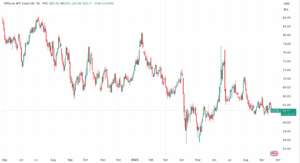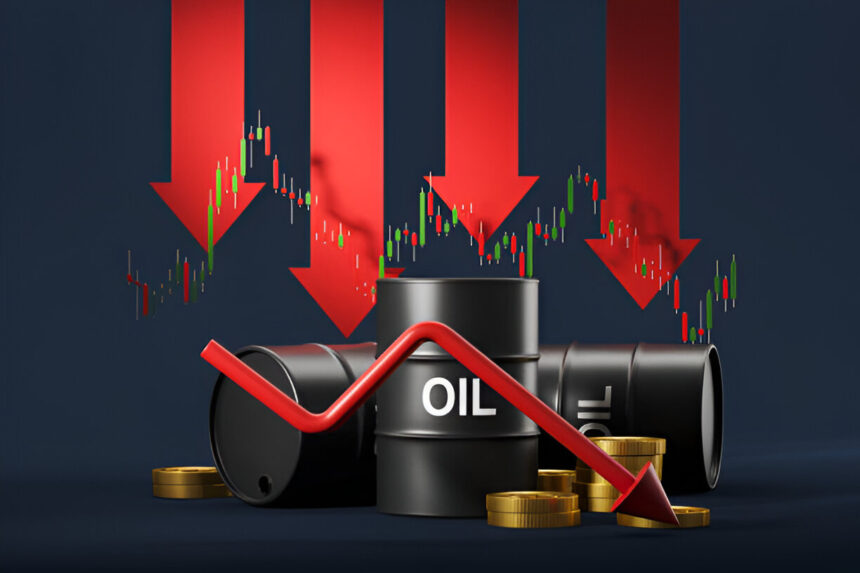The oil market around the world is at a critical point. The current oil market outlook shows that most forecasts say supply will be plentiful and prices will drop in two years. On the other side, there is a strong and perhaps underestimated wildcard is AI boom. The question is, can the surging energy demands of artificial intelligence infrastructure and the efficiency gains it brings to oil production fundamentally alter the market’s trajectory? In this article, we will explore the forces driving crude prices lower and assess the unprecedented role AI is beginning to play.
The Bearish Consensus: Institutional Forecasts for 2025-2026
There is an overwhelming consensus among market participants that the oil market is entering a phase of significant oversupply. This isn’t just a cyclical downturn; instead, it’s a structural shift where supply is outpacing demand. Just like a store that restocks its shelves much faster than customers can buy, this situation eventually leads to a drop in prices.
What are the key forecasts from major institutions?
Leading forecasters, including the U.S. Energy Information Administration (EIA), the International Energy Agency (IEA), and investment banks like J.P. Morgan and HSBC, all project a significant decline in crude prices. While their exact figures vary, the directional consensus is overwhelmingly bearish.
- U.S. Energy Information Administration (EIA): The EIA’s latest Short-Term Energy Outlook is perhaps the most stark. It projects Brent crude averaging in the high $60s in 2025 before a sharp drop to around $51 in 2026, with WTI following a similar path. The primary driver for this forecast is the expectation of large oil inventory builds, exceeding 2 million barrels per day, as OPEC+ members increase production.
- International Energy Agency (IEA): The IEA reinforces the oversupply narrative by focusing on the balance. The agency forecasts a supply surplus exceeding 2 million barrels per day in late 2025 and 2026. While they do not provide specific price targets, this level of surplus is a clear signal of downward pressure, implying that prices will struggle to remain elevated.
- J.P. Morgan: The investment bank’s research team has maintained a cautious outlook, projecting Brent at $66 in 2025 and a further decline to $58 in 2026. They cite robust non-OPEC+ supply, particularly from the U.S., and a U.S. policy preference for lower prices to combat inflation as key drivers.
- HSBC: HSBC also sees significant downside risk. The bank projects Brent around $65 in 2026 but warns of further declines due to massive projected surpluses of 1.7 mb/d in Q4 2025 and 2.4 mb/d in 2026. They note that unless geopolitical events intervene, the market fundamentals are firmly bearish.
- OPEC: Not surprisingly, OPEC is slightly more optimistic on the demand side, projecting demand growth of 1.3 mb/d in 2025. However, even the cartel is grappling with the reality of increasing supply from non-OPEC+ nations, which complicates their efforts to manage the market.
This uniformity in institutional outlook, spanning from government agencies to private sector banks, provides a strong signal that the market is primed for a steep decline unless a major external shock occurs.
What is driving the bearish outlook for oil prices?
Three primary factors contribute to the bearish outlook: a surge in supply from non-OPEC+ producers, sluggish global demand, and building inventories that are flooding the market.
- Supply Surge: Non-OPEC+ nations are pumping at near-record levels. The U.S. shale industry, in particular, continues to defy expectations, with production projected to hit 13.4 million barrels per day (mb/d) in 2025. This is coupled with new output from regions like Brazil and Guyana. Meanwhile, OPEC+ is beginning to unwind its voluntary production cuts, adding further barrels to an already saturated market.
- Weak Demand: Global oil demand growth is barely inching along, projected at less than 1 mb/d for both 2025 and 2026. Major economies in the OECD are showing flat or even declining consumption, and China’s economic slowdown is capping growth in non-OECD Asia. This contrasts sharply with the pre-pandemic era’s robust demand.
- Inventory Builds: As a direct result of the supply-demand imbalance, oil inventories are swelling. Surpluses are expected to exceed 2 mb/d through early 2026, filling up storage tanks and putting direct downward pressure on prices. The value of each barrel naturally decreases when the market is literally overflowing with crude.
This setup feels eerily familiar to the mid-2010s, when U.S. shale began its massive output surge. I recall observing analysts consistently raising their price targets, only to be taken aback by the overwhelming volume of new supply that overpowered the market, resulting in a dramatic price crash. The key lesson from that period was to not get so fixated on a single bullish narrative that you ignore the underlying, and often more powerful, fundamentals of supply and demand. The market always finds equilibrium, and currently, the supply side is in the lead.
The AI Wildcard: A Double-Edged Sword for the Oil Market
While the fundamental picture looks bleak, the rise of artificial intelligence introduces a fascinating and highly unpredictable variable. AI’s influence on energy markets is complex, encompassing both a significant demand for power and significant efficiency improvements.
How does the AI boom affect oil demand?
The AI boom’s primary effect on oil is indirect. Its immense power requirements will likely accelerate the demand for fossil fuels, especially natural gas, to support the global power grid, which in turn could lend support to oil prices.
- Massive Electricity Demand: Data centres, the physical homes of AI, are becoming energy hogs. They could account for up to 21% of global energy consumption by 2030, with AI alone driving a huge portion of that growth. This isn’t just a blip; it’s a new, structural source of demand.
- A Lifeline for Fossil Fuels: While clean energy is the long-term goal, the sheer scale and speed of AI’s energy needs mean that natural gas and even oil-derived fuels (for backup generators and industrial applications) will be required to fill the gap. Big tech giants are already signing massive energy contracts, with investments that dwarf many traditional sectors. This heightened demand for power generation could create a supportive floor for natural gas prices, and considering how interconnected energy markets are, oil prices could benefit.
Can AI-driven efficiency gains exacerbate the oil surplus?
Yes, AI is also a tool for efficiency, and its integration into the oil and gas sector could make a dangerous oversupply problem even worse. It helps producers get more out of every barrel, which increases the total available supply.
- Operational Optimisation: From seismic data analysis to predictive maintenance on drilling rigs, AI is making the oil production process smarter and leaner. It helps companies find new reserves more efficiently, optimise drill patterns to maximise yields, and prevent costly downtime.
- The Net Effect: In an environment already struggling with oversupply, these efficiency gains could reinforce the bearish trend. Companies can now operate profitably at lower prices, which means they are less likely to cut production even as prices fall. This creates a self-reinforcing cycle of high supply and low prices.
The net effect of the AI boom is a classic market paradox. The demand it creates could be a lifeline, but the efficiencies it generates could act as an anchor. Which force prevails will determine the balance, and the wise investors are closely monitoring this dynamic.
The Future: Navigating Volatility and Uncertainty
For investors and traders, the journey ahead is far from linear. The fundamental outlook is clearly bearish, but the market’s response to geopolitical shocks or a sudden acceleration in AI-driven energy consumption could create violent price swings.
- Scenario 1: The Deep Dive: The market plays out as expected. Non-OPEC+ supply continues to ramp up, and global economic growth remains tepid. In this scenario, Brent could easily test and break below the $50 mark by mid-2026.
- Scenario 2: The Geopolitical Spike: A major conflict in the Middle East or a significant disruption to a key shipping chokepoint could instantly wipe out the supply surplus, sending prices soaring back toward $70 or higher. These events are impossible to time, but the risk remains high.
- Scenario 3: The AI Shock: AI-driven energy demand explodes faster than expected. The grid struggles to keep up, relying more heavily than expected on fossil fuels. This could create sustained, albeit indirect, bullish pressure, perhaps keeping prices anchored above $60.
Having spent decades in the markets, I’ve learnt that the biggest profits often come from identifying a major, long-term trend, but the biggest losses come from ignoring short-term, sentiment driven catalysts. The current oil market is the perfect example of this. The fundamental case for lower prices is compelling, but the risk of a “black swan” event, it can be either a geopolitical flare-up or an unforeseen AI energy demand surge, is just as real. This isn’t a market for the complacent; it’s one that demands a dynamic strategy and constant re-evaluation of both macro trends and micro-catalysts.
Technical Outlook: The Charts Align with the Fundamentals
A look at the daily charts confirms the bearish bias, integrating principles from both Smart Money Concepts (SMC) and Elliott Wave Theory (EWT). A pattern of lower highs and lower lows characterises the price action.
- SMC Perspective: Since the April 2024 high, the market has been carving out a clear bearish structure. The recent rally from the July low was merely “inducement”, a classic move designed to trap retail traders into going long before the next leg down. The price has since rejected a key bearish order block (OB) around the $65–$68 level, signalling a likely continuation of the downtrend. A break and sustained move below the $62 support area will likely trigger a swift move toward the next major psychological level at $50.
- Elliott Wave Perspective: The current decline appears to be part of a larger corrective pattern. From an EW standpoint, we are likely in a Wave 5, which often marks the final, most emotional leg of a trend. The projected targets for this wave align perfectly with the fundamental forecasts, suggesting a potential bottom in the $49-$46 range.

These technical indicators aren’t just lines on a chart; they are a visual representation of the market’s collective psychology, and right now, that psychology is overwhelmingly bearish.
Final Takeaway: A Time for Caution and Calculated Risk
The 2025-2026 outlook for oil prices is a study in conflicting forces. The fundamentals, supported by a flood of supply and lacklustre demand, point to a clear bearish trend. However, the AI boom introduces a powerful and unpredictable element that could either deepen the downturn through efficiency or provide a surprising floor through its sheer energy appetite. The true expertise lies not in predicting which one wins, but in understanding both possibilities and having a strategy to navigate the inevitable volatility. The best course of action for a seasoned trader is to respect the overarching trend while remaining highly vigilant for the unexpected catalysts that could, in an instant, send the market in the opposite direction.
What are your thoughts on how AI will ultimately impact the future of energy? Share your perspective in the comments below.
Disclaimer: This blog is for informational purposes only and does not constitute financial advice. Always conduct your own research and consult a professional advisor before making investment decisions.







